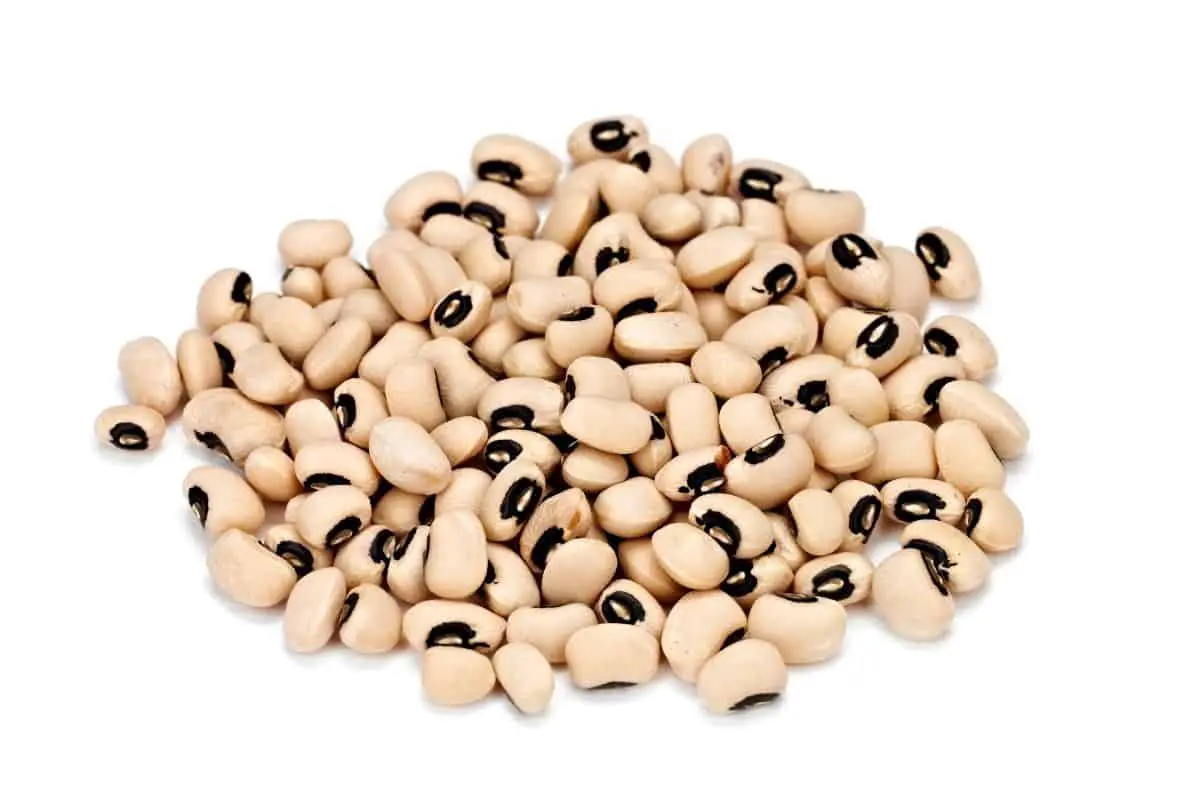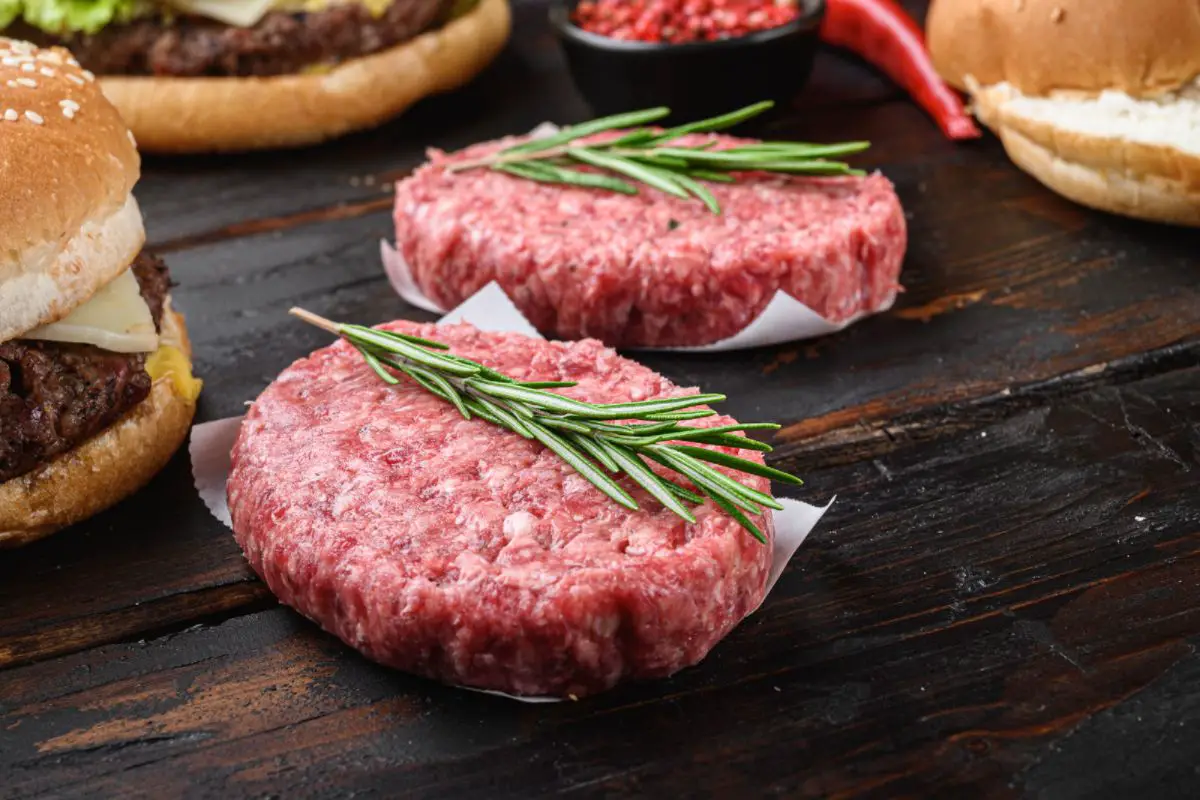This post contains affiliate links.
You’re cooking dinner, and you turn around to grab some salt when you spot your big furball smiling up at you, tongue out and puppy eyes activated, begging for scraps of what you’re cooking. You look in the pot where you’ve got some black-eyed peas boiling. But, can dogs eat black-eyed peas and are they safe?
Dogs can eat black-eyed peas, and they’re perfectly safe. Black-eyed peas are a rich source of protein and can give dogs their daily dose of fiber, key vitamins, and minerals to balance their diet. Black-eyed peas are also known to improve dogs’ digestion and give them healthy skin, fur, and vision.
Read on to learn about the nutritional value of black-eyed peas, what proportions to include in your dog’s diet, and how to prepare the beans before feeding.
Table of Contents
Black-Eyed Peas Are Safe and Healthy for Dogs
Black-eyed peas, also known as cowpeas, are distinct in appearance due to the dark black spot in the center of each bean. When cooked, they’re soft and tender, and add depth to any dish. They’re also loaded with nutrients that are an ideal for dogs and can safely be incorporated into most dogs’ diets.
Let’s take a look at the nutritional composition of black-eyed peas.
Black-Eyed Peas Are High in Protein
One cup (128 grams) of cooked black-eyed peas contains 5 to 6 grams (0.18 to 0.28 ounces) of protein. By a general rule of thumb, your dog will need 1 gram (0.035 ounce) high-quality protein per every pound of his body weight. This protein should ideally be animal protein, but needless to say, black-eyed peas are just as good an alternative, especially if he’s on a different kind of lifestyle-based diet.
The high protein content in black-eyed peas also means they’re suitable for weight-loss and weight-management, as they assist in building lean muscle and provide your dog with an extra boost of energy.
A large-breed, male, adult dog typically weighs somewhere between 60-75 pounds (27.22 to 34.02 kg). That means that one cup (128 grams) of cooked black-eyed peas will account for about 10-15% of his daily protein intake. With that in mind, you can always switch up his meal plan to make sure he gets enough protein, both plant-based and animal-based.
For the former, black-eyed peas are a great choice. For animal-based sources of protein, you can consider lean, white meats like chicken, fish, or other meats like beef, turkey, mutton and duck.
Plant-based protein, like you’d find in black eyed peas, also happens to be a great alternative, if you want to switch over from using protein powders.
Black-Eyed Peas Are Rich in Fiber
Again, that same cup of cooked black-eyed peas also contributes to the fiber in your dog’s diet. Ideally, 2%-4% of his diet should be fibrous content. One cup of black-eyed peas contains 8-9 grams (0.28 to 0.32 ounces) of fiber, so just do the math. Are you wondering why the fiber from black-eyed peas is so essential?
Well, those high levels of dietary fiber mean that your dog’s bowel movements, as well as his digestive health, will improve significantly. The fiber in the black-eyed peas makes it easy for his digestive system to work its magic.
Here’s a rough idea of how the process works:
- The fiber will absorb the water in the digestive tract.
- It will enable easy movement of the waste products down the tract and out the body.
The result? Healthy bowel movements with reduced risks of constipation for your dog.
Black-Eyed Peas Have Healthy Carbohydrates
All dogs need a decent amount of carbs in their diet, but not too much. Many pet owners forgo all but the most necessary amount of carbs in their dog’s diet to promote a healthier lifestyle. Depending on his activity levels, breed, age, and dietary needs, you can regulate just how many carbs your dog needs.
One cup (128 grams) of black-eyed peas contains 30-35 grams (1.06 to 1.23 ounces) of carbohydrates. That might seem like a lot of carbs, but keep in mind that as long as they’re not empty carbs from sugary treats and snacks, a reasonably active dog will work them off in no time.
Furthermore, black-eyed peas are a source of complex carbs that take longer—not harder—to digest than simple carbs. So, they also help your dog burn off more calories with everyday activities.
Black-Eyed Peas Have Vital Vitamins and Minerals
Apart from supplying the above, black-eyed peas are also an excellent source of:
- Vitamin A and K: Vitamin A helps improve your dog’s skin, hair, and coat. A deficiency of this vitamin can be seen in the form of a coarse, dull coat and poor night-vision in dogs. On the other hand, Vitamin K will help regulate the blood flow in his body, acting as an anticoagulant.
- Iron: Iron from black-eyed peas will help your dog with functions like carrying oxygen in the hemoglobin of RBCs to the rest of the body to produce energy as well as certain enzymes.
- Folate: Folate is a water-soluble B vitamin and what it does is help your dog’s body with cell growth and regeneration. Your dog needs adequate amounts of folate in his diet as a deficiency can cause poor digestion, lower his immunity and make him anemic.
- Magnesium: Proper doses of magnesium in your dog’s diet can help regulate his sleep.
- Potassium. The potassium you’ll find in them will help lower blood pressure and promote a healthy heart and lifestyle. Black-eyed peas are also proven to lower cholesterol.
Other vitamins and minerals found in black-eyed peas that boosts your dog’s diet and health include calcium, zinc, and copper.
How Much Black-Eyed Peas To Feed Your Dog
You’ve read about the nutritional content in one cup (128 grams) of cooked black-eyed peas, so now you’re probably wondering how much you should be mixing into your dog’s food.
Ideally, one single meal should contain both animal and plant-based ingredients, targeted to provide a wholesome supply of all essential vitamins and minerals, and additional supplements to your dog. With that in mind, one cup (128 grams) of black-eyed peas with every meal, on every alternate day should help to keep your dog well-nutritioned.
Although black-eyed peas are safe and healthy, feeding your dog too much can also have some negative side effects, such as excessive flatulence. Black-eyed peas have been known to cause flatulence in dogs and humans alike. That’s the layman’s term to say that black-eyed peas might make your dog gassy and smell nasty. However, that being said, this does vary from person to person, and dog-to-dog, as research indicates.
How To Integrate Black-Eyed Peas Into a Dog’s Diet
While most dogs might be eager to try whatever you put in front of them, not all are as willing. To get your dog to eat a healthy amount of black-eyed peas, you might have to get creative in your feeding methods. It’s vital to start out with smaller portions to test your dog’s reactions, before adding more beans to his diet.
Once you’ve established that your dog likes black-eyed peas and has no adverse reactions to them, you can then begin adding more into his food mixtures.
You can also consider baking the beans into a patty, and treat him to a nice plant-based burger. However, you can just quickly boil the beans along with his meat and call it a day.
Try to avoid feeding him beans out of a can as the water that they are soaked in will contain preservatives. While it is not toxic, it is something you can avoid. So this means your go-to choice of black-eyed peas is the dry variety.
How To Safely Prepare Black-Eyed Peas for Your Dog
Follow these instructions when preparing black-eyed peas for your dog’s consumption:
- Soak the beans overnight in water.
- Alternatively, there’s a quick-soak method that you can try. Just soak the beans in boiling water for an hour or two, and they should soften just enough to make them edible and easy to blend into a smooth puree.
- Let them cool down before you feed them to your dog.
- Add them as a topping to your dog’s traditional food, or serve plain.
It’s important not to feed him black-eyed peas as hummus, part of a dish like a chili or in other cooked dishes that include too much sodium, spices, or other ingredients that are not dog-friendly. Avoid adding salt and other additives to the beans.
Also consider that your dog might have an intolerance to black-eyed peas or just any type of beans in general. Always monitor his reactions after feeding, and remove them from his diet if you notice any vomiting or diarrhea. Remember to check his stools to see if he’s experiencing any discomfort processing, digesting, and finally ejecting the beans from his system.
Final Thoughts
Black-eyed peas are safe and healthy for dogs to consume and offer canines many nutritional benefits. As part of a balanced diet, black-eyed peas can provide wholesome, plant-based protein, and essential vitamins and minerals.
When feeding your dog black-eyed peas for the first time, it’s important to cook the beans thoroughly before serving, and ensure they’re soft and tender. Always start with small portions to test your dog’s reactions, before integrating black-eyed peas completely into his diet.
Related Articles
- Can Dogs Eat Edamame? (We Find Out!)
- My Dog Ate a Pine Cone: Here’s What To Do About It
- Can Dogs Eat Sage? (Is It Safe)
- Can Dogs Eat Thyme? (We Find Out)
- Can Dogs Eat Ketchup? Read This First!
Sources
- Healthline: Black-Eyed Peas (Cowpeas): Nutrition Facts and Benefits
- The National Academies Press: Your Dog’s Nutritional Needs
- WebMD: Health Benefits of Black Eyed Peas
- Wellness Pet Food: Choosing the Best Protein For Your Dog
- Cornell University College of Veterinary Medicine: Vitamin K Deficiency
- National Animal Supplement Council: Vitamin A Deficiency in Dogs
- Black Doctor.Org: 5 Amazing Reasons Why Your Body Needs More Black Eyed Peas
- Signal Hill Animal Clinic: FAQs
- American Kennel Club: Can Dogs Eat Peas?
Mrdogfood.com is a participant in the Amazon Services LLC Associates Program, an affiliate advertising program designed to provide a means for sites to earn advertising fees by advertising and linking to Amazon.com. We also participate in other affiliate programs which compensate us for referring traffic.






